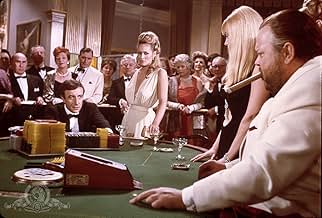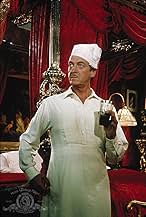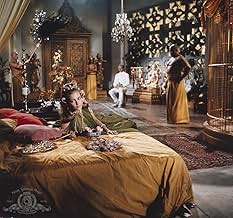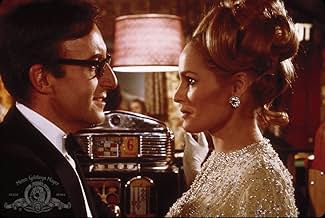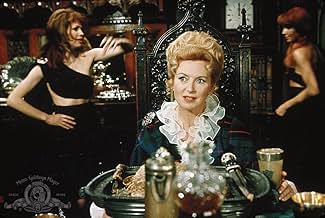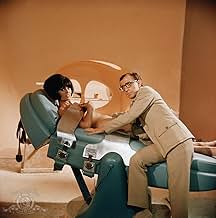VALUTAZIONE IMDb
5,0/10
34.023
LA TUA VALUTAZIONE
James Bond esce dal pensionamento per una nuova avventura.James Bond esce dal pensionamento per una nuova avventura.James Bond esce dal pensionamento per una nuova avventura.
- Candidato a 1 Oscar
- 4 candidature totali
Jean-Paul Belmondo
- French Legionnaire
- (as Jean Paul Belmondo)
Recensioni in evidenza
Occasional fun for the 60's lover, but completely incoherent as entertainment. I should confess that as a young kid I did love the film, just as I loved _What's new Pussycat_, and when I got a little older I became a guilty admirer of _The Blues Brothers_ and _1941_. So I am sucker for the comedy epic/ celebrity ensemble.
However, _Casino_ is simply over the top at being over the top. It seems impossible to create a successful film with 5 directors and 10 writers (not including Ian Fleming, but including Ben Hecht, Joseph Heller, Terry Southern and Billy Wilder !!). The story lacks even a real protagonist; Niven and Sellers trade places in that role. When they run out of story, pie fights emerge, or fusillades of bullets, or tremendous explosions.
The film is certainly not without its merits. Like _What's New Pussycat_ they did manage to corral some of the most beautiful women of the time together in the same film. When Andress is not speaking, as in the "Look of Love" sequence or in Seller's "shampoo" dream she's truly breathtaking. Allen is always funny, and Welles does a pretty good turn as le Chiffre. The Bacharach score and Herb Alpert open and closing sequences are memorable.
As a DVD extra, the American dramatic version of _Casino Royale_ (1954) is included on the DVD, which predated Connery by 8 years!!
However, _Casino_ is simply over the top at being over the top. It seems impossible to create a successful film with 5 directors and 10 writers (not including Ian Fleming, but including Ben Hecht, Joseph Heller, Terry Southern and Billy Wilder !!). The story lacks even a real protagonist; Niven and Sellers trade places in that role. When they run out of story, pie fights emerge, or fusillades of bullets, or tremendous explosions.
The film is certainly not without its merits. Like _What's New Pussycat_ they did manage to corral some of the most beautiful women of the time together in the same film. When Andress is not speaking, as in the "Look of Love" sequence or in Seller's "shampoo" dream she's truly breathtaking. Allen is always funny, and Welles does a pretty good turn as le Chiffre. The Bacharach score and Herb Alpert open and closing sequences are memorable.
As a DVD extra, the American dramatic version of _Casino Royale_ (1954) is included on the DVD, which predated Connery by 8 years!!
Casino Royale has some outstanding elements. The production design is worth a 10. There are beautiful, often provocatively dressed or relatively undressed women everywhere you look. Many of its segments are funny; it's even occasionally hilarious.
The problem arose in putting all of it together. And with at least five directors and at least ten writers, it's not difficult to see why. The whole is a mess. There is little in the way of overarching plot. Most threads are just completely abandoned after awhile.
The story, which is very loosely based on Ian Fleming's James Bond novel Casino Royale (published in 1953--it's the first Bond novel), is a spoof of the typical adventure featuring the infamous secret agent. The real Bond (David Niven) went into retirement when his skills were at their peak. This Bond is quite different than the Bond we know--he is almost chaste, he's a homebody, he dedicates each evening's twilight to playing Debussy on the piano, and so on. Casino Royale has it that the Bond we know from other films is a decoy.
A group of older men, representing the secret agencies of the US, the UK, Russia and France, are on their way to the real Bond's home to ask for his assistance. It seems that someone has been trying to wipe out as many secret agents as they can. While they're pitching the idea of coming out of retirement to Bond, they're attacked. Bond's house is blown up, and he (implicitly) agrees to the assignment. Casino Royale is the story of the real Bond trying to get to the bottom of the sinister agent-wipeout plan. Part of carrying that out involves changing the identity of nearly every spy to James Bond--if the real Bond is to work unimpeded, he can't always be worrying about being killed by the criminal mastermind.
Each director worked on a different segment in relative isolation from the rest. This went so far as having their own portions of the script written. The problem was that despite Eon Productions (the production company behind most of the Bond films) not owning the rights to Casino Royale, they had used many of the "bits" in other Bond films. So there wasn't much of the book left to adapt. In addition, it was felt that a serious alternative Bond film couldn't compete against the Albert R. Broccoli/Harry Saltzman-produced films. So Casino Royale producers Jerry Bresler, John Dark and Charles K. Feldman had different writer/director teams create their own, parodic Bond segments that would be loosely tied together--it was almost a filmic version of the "Exquisite Corpse" game, in which you fold a piece of paper so that you can't see other persons' work, and you have to continue the drawing on your section with only a couple visual anchors.
Each segment features a different set of stars--the primary sets centering on Niven, Woody Allen, and Peter Sellers with Ursula Andress and Orson Welles. Those are all great actors, and great comedians in at least two cases. They all do a bit of their own schtick--in some cases, they demanded this. Woody does his neurotic New York Jew character, Peter Sellers rides the gray area between bumbling buffoon and suave playboy, with a couple generic Indian and Chinese impersonations thrown in for good measure, Orson Welles does his best Paul Masson Wine-pitching "elder statesman" demeanor, and also throws in a few of his more famous magic tricks. All of this stuff is good, but does it work as a unified film? No. And if that's not enough evidence for you, consider that the segments were further chopped up into set-pieces. There's the "M", or McTarry funeral stuff, the Niven car chase stuff, the Sellers/Andress romance stuff, and so on. Each set piece ends up being largely independent--you could almost see this as a series of skits on a similar theme. These facts make Casino Royale not quite work. It's certainly no match for a legitimate Bond film, despite the similarity of location-hopping, outrageous villains, spy gadgets and so on.
But, in isolation, the segments tend to be good to excellent. The stretch with Bond visiting the faux M widow is probably the funniest. It also presages the Sir Robin section of Monty Python and the Holy Grail (1975), but bests it in a way, if only because of its extension. The madcap ending of the film is a lot of fun for its embrace of absurdism as a supreme aesthetic disposition--and it may have even influenced some later films. And the segments with the trippiest visuals, both in the climax, are a fantastic treat for any fan of surrealism. They're good enough to watch the film just to see them. The production design is incredible throughout the film. Not just for the surrealism, but the lush Edwardian and Victorian interiors, complete with copies and works in similar styles to unique, influential artists such as Gustav Klimt and Otto Dix.
If we felt like being overly generous, we might be able to argue that the overarching mess of a plot was part of the point. This is a spoof of Bond, after all, and Bond novels and films tend to have sprawling plots--both geographically and narratively. We do travel to many exotic locales, meet many exotic people, doing exotic things, and we receive many plot intricacies and twists in both the typical Bond story and in Casino Royale. However, Bond films aren't quite convoluted or messy enough to deserve this kind of spoofing, so excusing the messiness of the whole to parodic intent seems an over-ambitious stretch.
Casino Royale is worth seeing, particularly if you're a big Bond fan or a big fan of any of the cast, or even if you just like a lot of late 1960s/early 1970s big, madcap comedies. Just don't expect anything like a tight story.
The problem arose in putting all of it together. And with at least five directors and at least ten writers, it's not difficult to see why. The whole is a mess. There is little in the way of overarching plot. Most threads are just completely abandoned after awhile.
The story, which is very loosely based on Ian Fleming's James Bond novel Casino Royale (published in 1953--it's the first Bond novel), is a spoof of the typical adventure featuring the infamous secret agent. The real Bond (David Niven) went into retirement when his skills were at their peak. This Bond is quite different than the Bond we know--he is almost chaste, he's a homebody, he dedicates each evening's twilight to playing Debussy on the piano, and so on. Casino Royale has it that the Bond we know from other films is a decoy.
A group of older men, representing the secret agencies of the US, the UK, Russia and France, are on their way to the real Bond's home to ask for his assistance. It seems that someone has been trying to wipe out as many secret agents as they can. While they're pitching the idea of coming out of retirement to Bond, they're attacked. Bond's house is blown up, and he (implicitly) agrees to the assignment. Casino Royale is the story of the real Bond trying to get to the bottom of the sinister agent-wipeout plan. Part of carrying that out involves changing the identity of nearly every spy to James Bond--if the real Bond is to work unimpeded, he can't always be worrying about being killed by the criminal mastermind.
Each director worked on a different segment in relative isolation from the rest. This went so far as having their own portions of the script written. The problem was that despite Eon Productions (the production company behind most of the Bond films) not owning the rights to Casino Royale, they had used many of the "bits" in other Bond films. So there wasn't much of the book left to adapt. In addition, it was felt that a serious alternative Bond film couldn't compete against the Albert R. Broccoli/Harry Saltzman-produced films. So Casino Royale producers Jerry Bresler, John Dark and Charles K. Feldman had different writer/director teams create their own, parodic Bond segments that would be loosely tied together--it was almost a filmic version of the "Exquisite Corpse" game, in which you fold a piece of paper so that you can't see other persons' work, and you have to continue the drawing on your section with only a couple visual anchors.
Each segment features a different set of stars--the primary sets centering on Niven, Woody Allen, and Peter Sellers with Ursula Andress and Orson Welles. Those are all great actors, and great comedians in at least two cases. They all do a bit of their own schtick--in some cases, they demanded this. Woody does his neurotic New York Jew character, Peter Sellers rides the gray area between bumbling buffoon and suave playboy, with a couple generic Indian and Chinese impersonations thrown in for good measure, Orson Welles does his best Paul Masson Wine-pitching "elder statesman" demeanor, and also throws in a few of his more famous magic tricks. All of this stuff is good, but does it work as a unified film? No. And if that's not enough evidence for you, consider that the segments were further chopped up into set-pieces. There's the "M", or McTarry funeral stuff, the Niven car chase stuff, the Sellers/Andress romance stuff, and so on. Each set piece ends up being largely independent--you could almost see this as a series of skits on a similar theme. These facts make Casino Royale not quite work. It's certainly no match for a legitimate Bond film, despite the similarity of location-hopping, outrageous villains, spy gadgets and so on.
But, in isolation, the segments tend to be good to excellent. The stretch with Bond visiting the faux M widow is probably the funniest. It also presages the Sir Robin section of Monty Python and the Holy Grail (1975), but bests it in a way, if only because of its extension. The madcap ending of the film is a lot of fun for its embrace of absurdism as a supreme aesthetic disposition--and it may have even influenced some later films. And the segments with the trippiest visuals, both in the climax, are a fantastic treat for any fan of surrealism. They're good enough to watch the film just to see them. The production design is incredible throughout the film. Not just for the surrealism, but the lush Edwardian and Victorian interiors, complete with copies and works in similar styles to unique, influential artists such as Gustav Klimt and Otto Dix.
If we felt like being overly generous, we might be able to argue that the overarching mess of a plot was part of the point. This is a spoof of Bond, after all, and Bond novels and films tend to have sprawling plots--both geographically and narratively. We do travel to many exotic locales, meet many exotic people, doing exotic things, and we receive many plot intricacies and twists in both the typical Bond story and in Casino Royale. However, Bond films aren't quite convoluted or messy enough to deserve this kind of spoofing, so excusing the messiness of the whole to parodic intent seems an over-ambitious stretch.
Casino Royale is worth seeing, particularly if you're a big Bond fan or a big fan of any of the cast, or even if you just like a lot of late 1960s/early 1970s big, madcap comedies. Just don't expect anything like a tight story.
Eon Production's DR. NO was a great hit in the early 1960s, and Eon quickly snapped up the rights to the rest of Ian Flemming's novels about super spy James Bond--except for the CASINO ROYALE, which had already been purchased earlier by CBS for a 1950s television adaptation. When the property wound up at Columbia Pictures, they decided to create the satire to end all satires with a host of writers, five famous directors, and an all-star cast led by Peter Sellers. Unfortunately, Sellers' ego reached critical mass during the production and he was fired mid-way into filming--and suddenly roles that were originally envisioned as cameos had to be expanded to finish the project. The result is one of the most bizarre films imaginable.
The story, such as it is, finds James Bond (David Niven) called out of retirement to deal with the sudden disappearance of secret agents all over the world. In order to confuse the unknown enemy, Sir James orders ALL secret agents to use the name James Bond--and before you can blink there are Bonds aplenty running wild all over the globe. Eventually all the Bonds, including (through the magic of editing) Peter Sellers, wind up at Casino Royale, where they confront the evil agents of SMERSH and a diabolical mad man with a plot to rule the world.
The plot is absolute chaos, but that doesn't prevent the film from being a lot of fun to watch. The entire cast runs wild with some marvelous over-the-top performances, and whenever the writers can jam in a gag or a weird plot turn they do precisely that: Bond (Niven) is attacked by decoy ducks; counter-agent Mimi (Deborah Kerr) swings from a drain pipe; Bond's daughter by Mata Hari (Joanna Pettet) is kidnapped by a UFO; double agent Vesper (Ursula Andress) hides bodies in the deep freeze. And that's just for starters.
At one point Niven blows up the locked door of a psychedelically decorated dudgeon with lysergic acid--better know as LSD--and in a way this is indicative of the entire film, which was made at the height of the 1960s ultra-mod movement: the whole thing has the feel of a blow-out acid trip, right down to flashing multicolored lights and swinging 60s fashions. It is visually arresting, to say the least. And then there is that famous Burt Bacharach score, easily one of the best of the decade, sporting Herp Albert on the main theme and Dusty Springfield's legendary performance of "The Look of Love." On the whole, the film is one of the most entertaining hodgepodges of talent and weirdness I've ever encountered, and it never fails to amuse. I've found that viewers tend to have extremely different reactions to this film--they either love it or hate it, so you may want to rent this one first. But it's one of my favorite guilty pleasures, and I recommend it for fans of the unexpectedly odd.
Gary F. Taylor, aka GFT, Amazon Reviewer
The story, such as it is, finds James Bond (David Niven) called out of retirement to deal with the sudden disappearance of secret agents all over the world. In order to confuse the unknown enemy, Sir James orders ALL secret agents to use the name James Bond--and before you can blink there are Bonds aplenty running wild all over the globe. Eventually all the Bonds, including (through the magic of editing) Peter Sellers, wind up at Casino Royale, where they confront the evil agents of SMERSH and a diabolical mad man with a plot to rule the world.
The plot is absolute chaos, but that doesn't prevent the film from being a lot of fun to watch. The entire cast runs wild with some marvelous over-the-top performances, and whenever the writers can jam in a gag or a weird plot turn they do precisely that: Bond (Niven) is attacked by decoy ducks; counter-agent Mimi (Deborah Kerr) swings from a drain pipe; Bond's daughter by Mata Hari (Joanna Pettet) is kidnapped by a UFO; double agent Vesper (Ursula Andress) hides bodies in the deep freeze. And that's just for starters.
At one point Niven blows up the locked door of a psychedelically decorated dudgeon with lysergic acid--better know as LSD--and in a way this is indicative of the entire film, which was made at the height of the 1960s ultra-mod movement: the whole thing has the feel of a blow-out acid trip, right down to flashing multicolored lights and swinging 60s fashions. It is visually arresting, to say the least. And then there is that famous Burt Bacharach score, easily one of the best of the decade, sporting Herp Albert on the main theme and Dusty Springfield's legendary performance of "The Look of Love." On the whole, the film is one of the most entertaining hodgepodges of talent and weirdness I've ever encountered, and it never fails to amuse. I've found that viewers tend to have extremely different reactions to this film--they either love it or hate it, so you may want to rent this one first. But it's one of my favorite guilty pleasures, and I recommend it for fans of the unexpectedly odd.
Gary F. Taylor, aka GFT, Amazon Reviewer
This was the Bond title unable to be used by the filmmakers of the regular Bond film series, until the end of the century (they finally got to it for the restart in 2006). So, the intent here was a spoof of the then-wildly popular Bond/spy mania of the mid-sixties. Of course, this wasn't the first such effort; others already began the "Our Man Flint" duo film series and "The Man From UNCLE" on TV was in full swing, not to mention "Get Smart." So, how to outdo them? Get five top notch directors. Get as many sixties stars as possible. Get everything but the kitchen sink (literally, in the over-the-top climax). The original intent was to have each director do their own little mini-movie spoof - an anthology; they ended up editing everything together into one so-called film. A heady brew and, predictably, largely incomprehensible. In addition, actor Sellers, the nominal star, left before completing all his scenes, so his personal trajectory is less than smooth - as if a scene is missing, naturally. If you pay very close attention, you might be able to follow about 50% of the plot, but do you really want to put so much effort into watching a comedy?
Some of this editing is quite clumsy: the first pre-credits scene, a short one, features Sellers, as if the producers are pointing out to us that he is indeed in this movie (he doesn't show up again until 40 minutes later). Welles doesn't show up until the 80-minute mark. The first sequence concentrates on Niven, the real James Bond. He's in retirement but is forced back into a weird plot by the heads of all the world's spy agencies. This first half-hour, except for the scene with the lions, is slow and mostly stupid, not funny-stupid as intended, involving Kerr and a lot of dull fun at the expense of the Irish, for some reason, and painfully obvious joking about Bond's sexual magnetism. There's also one sly poke at the real Bond film series and its gadgetry; apparently, that Bond, of "Goldfinger" and "Thunderball" fame, is actually a replacement for the pure spy played by Niven, who looks down at the concept of gadgets. Things start to pick up a bit later, with the intro of several femme fatales, played by some of the most ravishing starlets of the sixties: Andress of "Dr.No" fame, Bouchet as the new Moneypenny, Lavi and Pettet as Bond's daughter, Mata (why Pettet did not become a major star is baffling to me). Much of the non-plot involves Niven taking over M's operations and naming a bunch of other agents James Bond to confuse the enemy - SMERSH (lifted straight from the books). We finally do see similar plot lines to Fleming's novel, involving villain heavy Le Chiffre (Welles) and one of the Bonds (Sellers) dueling at cards (Baccarat - dramatized differently in the 1954 TV version, yet eerily similar).
Curiously, it's not Sellers who provides the more amusing scenes in this confusing fest, as we would expect. No, that honor falls to Woody Allen, as Bond's nephew, and Welles in his brief scenes conducting some off-the-cuff magic show. Allen's highlight is his very first scene, involving the firing squad. Allen, previously seen in "What's New,Pussycat?," now proves to be one of the most natural comedians for the silver screen. His mannerisms and body movement recall some of the great comedians of the silent era, Chaplin & Keaton, especially evident in the scenes where he can't speak (a mental block whenever Uncle Bond is around). Famous starlet of the seventies Ms.Bisset pops up briefly in a small role as yet another femme fatale. There's also some mildly amusing commentary on the division of East and West Berlin - yes, this was the height of the Cold War - including some almost-clever use of color. But, all the psychedelic stuff, crammed into the tail end of this, is very outdated and useful only if the viewer has smoked a lot of weed. This movie also has one of the worst musical scores - almost like nails on chalkboard to me. If you're in a really good mood, you may be able to sit through this long movie comfortably; if not, you'll probably get pretty antsy as the last third begins - and that's where most of Woody's scenes are. Bonds:4 Villains:6 Femme Fatales:7 Henchmen:4 Fights:3 Stunts/Chases:5 Gadgets:4 Locations:8 Pace:4 overall:5-
Some of this editing is quite clumsy: the first pre-credits scene, a short one, features Sellers, as if the producers are pointing out to us that he is indeed in this movie (he doesn't show up again until 40 minutes later). Welles doesn't show up until the 80-minute mark. The first sequence concentrates on Niven, the real James Bond. He's in retirement but is forced back into a weird plot by the heads of all the world's spy agencies. This first half-hour, except for the scene with the lions, is slow and mostly stupid, not funny-stupid as intended, involving Kerr and a lot of dull fun at the expense of the Irish, for some reason, and painfully obvious joking about Bond's sexual magnetism. There's also one sly poke at the real Bond film series and its gadgetry; apparently, that Bond, of "Goldfinger" and "Thunderball" fame, is actually a replacement for the pure spy played by Niven, who looks down at the concept of gadgets. Things start to pick up a bit later, with the intro of several femme fatales, played by some of the most ravishing starlets of the sixties: Andress of "Dr.No" fame, Bouchet as the new Moneypenny, Lavi and Pettet as Bond's daughter, Mata (why Pettet did not become a major star is baffling to me). Much of the non-plot involves Niven taking over M's operations and naming a bunch of other agents James Bond to confuse the enemy - SMERSH (lifted straight from the books). We finally do see similar plot lines to Fleming's novel, involving villain heavy Le Chiffre (Welles) and one of the Bonds (Sellers) dueling at cards (Baccarat - dramatized differently in the 1954 TV version, yet eerily similar).
Curiously, it's not Sellers who provides the more amusing scenes in this confusing fest, as we would expect. No, that honor falls to Woody Allen, as Bond's nephew, and Welles in his brief scenes conducting some off-the-cuff magic show. Allen's highlight is his very first scene, involving the firing squad. Allen, previously seen in "What's New,Pussycat?," now proves to be one of the most natural comedians for the silver screen. His mannerisms and body movement recall some of the great comedians of the silent era, Chaplin & Keaton, especially evident in the scenes where he can't speak (a mental block whenever Uncle Bond is around). Famous starlet of the seventies Ms.Bisset pops up briefly in a small role as yet another femme fatale. There's also some mildly amusing commentary on the division of East and West Berlin - yes, this was the height of the Cold War - including some almost-clever use of color. But, all the psychedelic stuff, crammed into the tail end of this, is very outdated and useful only if the viewer has smoked a lot of weed. This movie also has one of the worst musical scores - almost like nails on chalkboard to me. If you're in a really good mood, you may be able to sit through this long movie comfortably; if not, you'll probably get pretty antsy as the last third begins - and that's where most of Woody's scenes are. Bonds:4 Villains:6 Femme Fatales:7 Henchmen:4 Fights:3 Stunts/Chases:5 Gadgets:4 Locations:8 Pace:4 overall:5-
To watch this movie, one must understand something that many appeared to have missed. Chiefly, the mish-mashed, ridiculous, over-blown insanity of it is the entire point. It is this that it aims for, and this that it achieves. It is not really a story, so much as every conceivable joke that could be thought of, thrown into an editing studio and spat out the other end as gold. This movie will challenge many who cannot break-out of the mold of needing a firm plot and some commonsense, but in this regard it is much like a comedic version of a David Lynch film, and I enjoyed Twin Peaks: The Movie even if I still don't get it.
So watch this for the crackling one-liners, ridiculously pretty women, lurid sets and the most completely unself-conscious approach to making a comedy that I have ever seen. It goes beyond funny, and becomes a matter of being shocked into admiration for the sheer silliness of it all. And the fun of trying to explain it to someone afterwards is immeasurable.
"So then the flying-saucer kidnaps Mata Hari and James Bond's love-child, and then James Bond who's David Niven and James Bond who's Woody Allen face-off, and meanwhile James Bond is being tortured with insane hallucinations and someone has snuck into his delusions with a machine-gun bagpipe and through all this Deborah Kerr was a French Scotswoman!"
Much less a true story than very funny surrealist art. Like Salvidor Dali meets The Pythons, but odder. And lots of great satire and stuff, too. See it. Now. If only to broaden your horizons.
So watch this for the crackling one-liners, ridiculously pretty women, lurid sets and the most completely unself-conscious approach to making a comedy that I have ever seen. It goes beyond funny, and becomes a matter of being shocked into admiration for the sheer silliness of it all. And the fun of trying to explain it to someone afterwards is immeasurable.
"So then the flying-saucer kidnaps Mata Hari and James Bond's love-child, and then James Bond who's David Niven and James Bond who's Woody Allen face-off, and meanwhile James Bond is being tortured with insane hallucinations and someone has snuck into his delusions with a machine-gun bagpipe and through all this Deborah Kerr was a French Scotswoman!"
Much less a true story than very funny surrealist art. Like Salvidor Dali meets The Pythons, but odder. And lots of great satire and stuff, too. See it. Now. If only to broaden your horizons.
Lo sapevi?
- QuizPeter Sellers and Orson Welles hated each other so much that the filming of the scene where both of them face each other across a gaming table actually took place on different days with a double standing in for the other actor.
- BlooperIn the "vault" scene towards the end, Bond says, "Careful, it's vaporized lysergic acid, highly explosive". Lysergic acid, used in the synthesis of the hallucinogen LSD, is not explosive at all.
- Citazioni
Piper: Excuse me. Are you Richard Burton?
Evelyn Tremble: No, I'm Peter O'Toole!
Piper: Then you're the finest man that ever breathed.
- Curiosità sui creditiThe opening credit animation by Richard Williams parodies illuminated manuscripts with cartoon-style calligraphy. It sets the tone for the film as a psychedelic "knight's tale" of Sir James Bond.
- Versioni alternativeIn the Region 2 DVD which has English, German, French, Italian and Spanish audio tracks, the ending is left instrumental in Spanish audio track unlike the others.
- ConnessioniEdited into The Clock (2010)
I più visti
Accedi per valutare e creare un elenco di titoli salvati per ottenere consigli personalizzati
Dettagli
- Data di uscita
- Paesi di origine
- Lingue
- Celebre anche come
- Casino Royale
- Luoghi delle riprese
- Azienda produttrice
- Vedi altri crediti dell’azienda su IMDbPro
Botteghino
- Budget
- 12.000.000 USD (previsto)
- Lordo in tutto il mondo
- 2783 USD
- Tempo di esecuzione
- 2h 11min(131 min)
- Colore
- Proporzioni
- 2.39 : 1
Contribuisci a questa pagina
Suggerisci una modifica o aggiungi i contenuti mancanti


